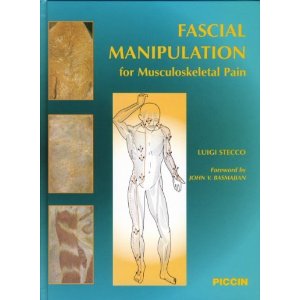
How and where Fascial Manipulation works
"Fascial Manipulation affects principally the ground substance of the fascia. The ground substance unites cells and influences their development, polarity, and behavior. It contains various protein fibers interwoven in a hydrophilic gel composed of GAGs (glycoaminoglycans). The constituent protein of these fibers can be divided into structural protein (collagen and elastin) and adhesive protein (fibronectin and lamina).
The GAGs are divided fundamentally into two groups: hyaluronic acid (not sulphate) and sulphate GAGs. The first is more abundant in the loose connective tissues and facilitates cell migration during morphogenesis and tissue repair processes. For example, it can increase or inhibit the activity of the fibroblast growth factor. The sulphate GAGs are more common in dense packed connective tissues.
GAGs are very gelatinous and are responsible for the viscosity of the extracellular matrix. Apart from hyalonuric acid, GAGs are attached to non-collagenous proteins forming macromolecules called proteoclycans. GAGs can unite many ions and the nature and concentration of the electrolytes influences the macromolecular structure. This can vary from loose to twisted, with consequent changes in viscosity of the solution. Furthermore, proteoglycans can interact via electrostatic attachments with collagen influencing the morphology and the function of the connective tissue fibers. Links between fibronectin and collagen can also be modulated by various GAGs.
In conclusion, densification of the ground substance hinders collagen fiber orientation in response to applied traction, as well as impeding aligned collagen fibers from gliding between one another. Diminished elasticity of the fascia determines incoordination between the muscular fibers of single mf units and between the mf units of a myofascial sequence.
This is where Fascial Manipulation intervenes, creating local heat through friction as well as a local inflammation. The heat immediately modifies the consistency of the ground substance. The inflammation intervenes in the following hours, as the extracellular proteolytic enzymes secreted locally from cells collaborate in the degeneration of matrix proteins (collagen and fibronectin).
Turnover of collagen and other macromolecules of the extracellular matrix is normally very slow. Hence, unless an external intervention such as Fascial Manipulation is applied, a patient could take years to recover from pain generated by a fascial densification and in the meantime, compensations and counter compensations multiply."
(Stecco, The Myofascial Sequence, p.154-155)
Learn from thought leaders like Stecco at the 2013 BSMPG Summer Seminar May 17 & 18, 2013 in Boston MA. Register today before seats fill up.
A special thanks to our top sponsors:




